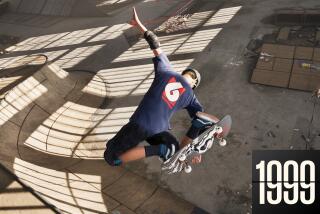Skateboarder’s Pipe Dreams Become Reality
VENTURA — Erik Payne began his career at age 12, in his own backyard. With his parents’ permission, he built two skateboarding ramps--a half-pipe in the back and a quarter-pipe in the frontyard.
Fifteen years later, he has turned his childhood passion into a burgeoning career as the builder of cutting-edge skateboard parks and facilities from Southern California to places as far away as Japan and Austria.
The recently married 27-year-old owner-operator of Ventura-based Epic Ramps has been skateboarding for more than 17 years and his love for the sport has paid off. With skateboarding more popular now than ever, and with skate parks popping up all over, his expertise is in high demand.
Payne is a genuine plywood artist. He has built one ramp that resembles a gigantic cereal bowl and another that curls like the lip of a pounding wave. In his mind, the Zen of ramp construction is more than just a hammer and nails. It’s a form of functional art. And the sounder the construction, the smoother the ride.
“The more I do, the more I learn about efficient construction while maintaining the ramp’s structural integrity,” Payne said. “Now it’s all common sense.”
Check out one of his U-shaped “vert ramps” and you will wonder how anyone could surrender to the 15-foot vertical drop. But Payne said his crew always gets the first test run. “And at this point, I can skate almost anything--just not that well,” he added with a laugh.
It’s a far cry from his 12-year-old backyard ramp-building days.
*
After graduating from Buena High School, Payne studied at Ventura College while perfecting his basic construction skills on various church trips. He went overseas twice with Teen Missions and took repeat trips to Mexico, building dorms and sheds for people in need.
Payne’s big break came when he was hired as project manager for Skate Street, Ventura in late 1996.
There he met Mike Taylor, John Oliver Sr. and John Oliver Jr., three of the masterminds behind the Powell SkateZone in Santa Barbara, which closed in the early ‘90s. As project manager, his job was to ensure that the work was sound and finished in a timely manner.
It was then that his specialized education began.
“A lot of this is learned very practically,” Payne said. “The most difficult thing is to utilize the spaces well and then to settle on an idea. It’s easy to put too much into a park, but it has to be functional.”
Payne began to refine his craft, earning the respect of local and national boarders alike.
Sasha Steinhorst, manager of the Etnies clothing company’s pro team and an avid skateboarder himself, commented on Payne’s ramp construction after a recent pro demonstration: “These ramps [at Skate Street] have lasted as long as this park has been here, and they’ve really been beat up. That says something. The construction is sound.”
*
Taylor, who was named the Most Important Man in Skateboarding in 1997 by Transworld magazine, also has a love for ramp building. After finishing the project, he and Payne wanted to work together again. When people began asking about other projects, they were off and running.
“We found that we were very compatible, and we decided to seek out other options,” said Taylor, who also works for Powell Skateboarding Co. in Santa Barbara. “Since then, we’ve worked together on over 20 projects, we’ve consulted with people all over the country, we’ve worked with computer designs and clay models.”
Payne and Taylor have built a skate park on Mt. Hermon in Santa Cruz. They also have built ramps at summer camps; helped design a park in Temecula; were involved in a park in Osaka, Japan; worked on temporary parks in Carpinteria and Santa Barbara; designed and built a park in Austria; and are currently working on park for the city of Ojai. In addition, Payne has continued maintenance at Skate Street with new mini ramps and trick ramps.
In his off time, you might find Payne tearing around on his dirt bike in the back hills of Ojai, playing his guitar and singing or spending time with his wife, Candi. When discussing the future of his business, his priorities are clear. “I’m not into traveling a lot,” he said. “I’m concerned about my marriage.”
Payne’s next project? Skate Street, chapter two.
Skate Street “is a modern park, and in terms of structural integrity, it’s well-respected,” he said. “But the new park will be better. This time, we bring into it all the experience we’ve had design-wise and construction-wise. It will be more functional and more modern.”
There is even a place on Skate Street’s Web site where skaters can vote for their choice of ramp design in the new park. The current debate is between a large “vert ramp,” which is a beginning skater’s nightmare, or a “bowl,” far more practical for the everyday skater.
*
For the new park, Payne will use a new plastic material called Skatelite, which was originally produced for a variety of marine applications. “Skatelite isn’t slippery, has long-term value and is entirely weatherproof,” he said.
Having come full circle from the old to the new Skate Street, Payne is looking to the future.
“Skateboarding is growing rapidly into a regular sport,” he said. “The pros are being pushed to be respectful, to be more professional, and the sport is more popular now than it’s ever been.”
And Payne plans to be along for the ride.


